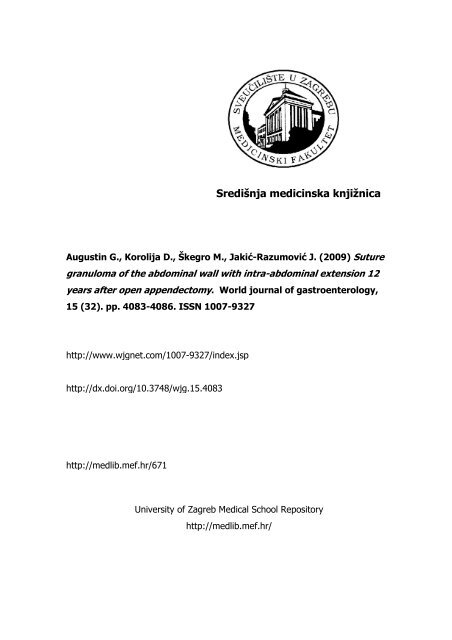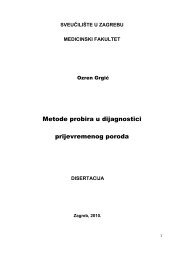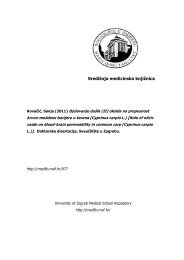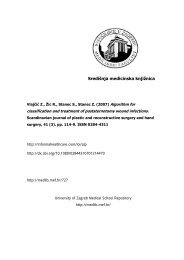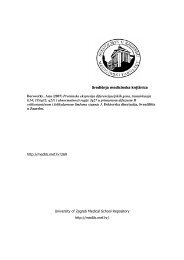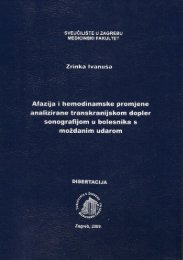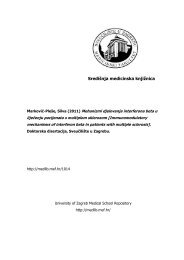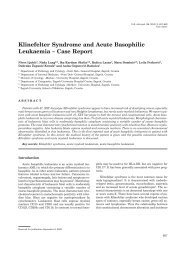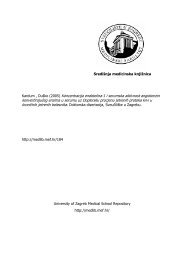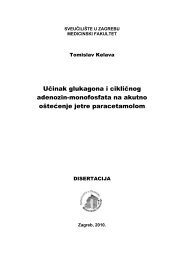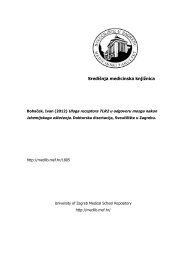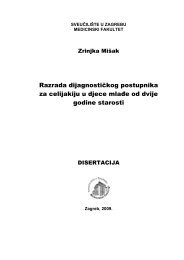Suture granuloma of the abdominal wall with intra-abdominal ...
Suture granuloma of the abdominal wall with intra-abdominal ...
Suture granuloma of the abdominal wall with intra-abdominal ...
You also want an ePaper? Increase the reach of your titles
YUMPU automatically turns print PDFs into web optimized ePapers that Google loves.
Središnja medicinska knjižnicaAugustin G., Korolija D., Škegro M., Jakić-Razumović J. (2009) <strong>Suture</strong><strong>granuloma</strong> <strong>of</strong> <strong>the</strong> <strong>abdominal</strong> <strong>wall</strong> <strong>with</strong> <strong>intra</strong>-<strong>abdominal</strong> extension 12years after open appendectomy. World journal <strong>of</strong> gastroenterology,15 (32). pp. 4083-4086. ISSN 1007-9327http://www.wjgnet.com/1007-9327/index.jsphttp://dx.doi.org/10.3748/wjg.15.4083http://medlib.mef.hr/671University <strong>of</strong> Zagreb Medical School Repositoryhttp://medlib.mef.hr/
INTRODUCTIONAppendicitis became recognized as a surgical disease when Reginald Heber Fitz correctlypointed out that <strong>the</strong> frequent abscesses in <strong>the</strong> right iliac fossa were <strong>of</strong>ten due toperforation <strong>of</strong> <strong>the</strong> vermiform appendix, and he referred to <strong>the</strong> condition as appendicitis [1] .Since that discovery and <strong>the</strong> development <strong>of</strong> various incisions and appendectomytechniques, many early and late postoperative complications and coincident conditionsbecame evident. One <strong>of</strong> <strong>the</strong>m is postoperative <strong>abdominal</strong> <strong>wall</strong> mass in <strong>the</strong> region <strong>of</strong>McBurney's muscle-splitting incison. Diagnosis and management <strong>of</strong> <strong>abdominal</strong> <strong>wall</strong>masses after open appendectomy present challenges because various conditions:appendectomy-related, primary-local (appendectomy-unrelated), primary-systemic couldbe <strong>the</strong> causes <strong>of</strong> <strong>abdominal</strong> <strong>wall</strong> masses postoperatively. This case presents <strong>the</strong> firstknown case <strong>of</strong> a suture <strong>granuloma</strong> <strong>with</strong> <strong>intra</strong>-<strong>abdominal</strong> extension as a cause <strong>of</strong><strong>abdominal</strong> <strong>wall</strong> mass after open (muscle-splitting) appendectomy.CASE REPORTA 75 year-old woman presented <strong>with</strong> a slightly painful palpable mass in <strong>the</strong> right lowerabdomen lasting for six months. The pain in right lower quadrant was described ascontinuous, nonradiating, mild and nondisturbing. There was no nausea and vomiting.The body temperature was 36.8oC and bowel movements were normal. She lost 10 kgduring last three months before presentation. The patient had undergone <strong>the</strong> openappendectomy (muscle-splitting incision) 12 years previously. Five years ago she hadundergone vaginal hysterectomy <strong>with</strong> bilateral salphingo-oophorectomy for uterine
leiomyomata. After both operations <strong>the</strong> patient was in good health and <strong>with</strong>out anysimptoms and complaints. She did not take any medications. Physical examinationrevealed a slightly tender mass, 10 cm in diameter, under <strong>the</strong> appendectomy scar in <strong>the</strong>right lower abdomen. The swelling was elastic and poor in mobility. O<strong>the</strong>r resistancescould not be found, and all o<strong>the</strong>r parts <strong>of</strong> <strong>the</strong> physical examination showed no fur<strong>the</strong>ranomalies.The preoperative laboratory findings and plain <strong>abdominal</strong> radiographs werenormal. Tumor markers were as follows: CEA=2.42 µg/L; AFP 1.24 µg/L; CA19.9=4.89kU/L and CA 125=5.80 kU/L. Abdominal ultrasonography demonstrated low-echoicmass lesion 8 x 8 cm just lateral to cecum and in communication <strong>with</strong> lateral <strong>abdominal</strong><strong>wall</strong>. No peristalsis or communication <strong>with</strong> <strong>the</strong> bowel lumen was observed.Esophagogastroscopy revealed chronic gastritis and colonoscopy revealed sigmoiddiverticulosis and normal mucosa in <strong>the</strong> cecum <strong>with</strong> normal ileocoecal valve. Multi-sliceCT scan showed inhomogenous <strong>abdominal</strong> mass <strong>with</strong> minimal vascularization in <strong>the</strong> rightlower abdomen 8.6 x 8 x 9 cm that communicate <strong>with</strong> <strong>abdominal</strong> <strong>wall</strong>. Abdominal <strong>wall</strong>was thickened, weak and bulging (Figure 1). There was no communication between <strong>the</strong>cecum and <strong>abdominal</strong> <strong>wall</strong> also confirmed by previous colonoscopy (Figure 2). From thisfindings <strong>abdominal</strong> <strong>wall</strong> tumor was suspected and elective operation was performed.After midline laparotomy and adhesiolysis, greater omentum was detached from<strong>the</strong> mass in <strong>the</strong> right lower abdomen located <strong>intra</strong>peritoneally. There was no free<strong>intra</strong>peritoneal fluid or fibrin deposits. The elastic mass was adherent to <strong>abdominal</strong> <strong>wall</strong>and <strong>the</strong>re was no communication <strong>with</strong> small and large bowel, retroperitoenal or vascularstructures. After partial omentectomy <strong>the</strong> mass was completely extirpated from <strong>the</strong><strong>abdominal</strong> <strong>wall</strong> (Figure 3). Histopathological examination revealed foreign-body<strong>granuloma</strong> <strong>with</strong> central abscess (Figure 4). The patient's early postoperative course was
uneventful and she left <strong>the</strong> hospital on <strong>the</strong> 10th postoperative day. On several controlexaminations during <strong>the</strong> first 18 months patient was completely symptomless.DISCUSSIONThis case represents an unusual complication <strong>of</strong> suture <strong>granuloma</strong> <strong>with</strong> <strong>intra</strong>-<strong>abdominal</strong>extension as a cause <strong>of</strong> <strong>abdominal</strong> <strong>wall</strong> mass 12 years after open appendectomy. To ourknowledge (Medline search 1962-2007) this is <strong>the</strong> third case <strong>of</strong> such complication afterappendectomy. Abdominal <strong>wall</strong> abscesses after appendectomy was diagnosed byMatsuda et al. 11 years postoperatively [2] and Ichimiya M et al. 25 yearspostoperatively [3] .Unique feature in our case is <strong>intra</strong><strong>abdominal</strong> extension <strong>of</strong> <strong>abdominal</strong> <strong>wall</strong> suture<strong>granuloma</strong> <strong>with</strong> central abscess which complicated definitive diagnosis.Since <strong>the</strong> development <strong>of</strong> various incisions and appendectomy techniques, manyearly and late postoperative complications and coincident conditions became evident. One<strong>of</strong> <strong>the</strong>m is postoperative <strong>abdominal</strong> <strong>wall</strong> mass in <strong>the</strong> region <strong>of</strong> McBurney's musclesplittingincison. Morbidity associated <strong>with</strong> appendectomy is could be as high as 25% incomplicated cases [4] . Morbiditiy could be divided into early and late complications. Earlycomplications are more common and mostly include wound hematoma, seroma, abscessor <strong>intra</strong>-<strong>abdominal</strong> abscess due to persistence <strong>of</strong> cavities between <strong>the</strong> muscle layers and<strong>the</strong> subcutaneous tissue which encourages fluid collections [5] . These complications canturn into cystic formations or masses that can simulate a tumor <strong>of</strong> <strong>the</strong> <strong>abdominal</strong> <strong>wall</strong>, if<strong>the</strong>y are not readily solved. For this reason, a meticulous surgical technique, carefulhaemostasis and placement <strong>of</strong> suction drains in <strong>the</strong> subcutaneous tissue is recommended,principally in obese patients [6] . Late complications are rare and some <strong>of</strong> <strong>the</strong>m includeobstruction due to adhesions, postoperative hernia or progression <strong>of</strong> inflammatory bowel
disease not evident at operation for suspected appendicitis. Most <strong>of</strong> <strong>the</strong>se complicationscould present as <strong>abdominal</strong> mass. Abdominal mass as primary pathology or postoperativefinding always makes precise preoperative diagnosis difficult. Complete list <strong>of</strong>differential diagnosis <strong>of</strong> late presenting <strong>abdominal</strong> <strong>wall</strong> masses after open appendectomyis listed in Table 1.Several points should be stressed. First, <strong>abdominal</strong> <strong>wall</strong> masses could be: 1)appendectomy-related, 2) primary, 3) posttraumatic and 4) related to o<strong>the</strong>r interventionsin <strong>the</strong> surrounding area for o<strong>the</strong>r pathologic conditions. Thus history taking and physicalexemination are crucial. Time interval from appendectomy is essential because itdetermines <strong>the</strong> difference between early and late complications <strong>of</strong> appendectomy.Fur<strong>the</strong>rmore, symptoms and signs <strong>of</strong> unrelated diseases (local or systemic) should beconfirmed or ruled out (<strong>abdominal</strong> <strong>wall</strong> tumors, extension <strong>of</strong> <strong>intra</strong>-<strong>abdominal</strong> malignancy,endometriosis, lymphoprolipherative disorders etc.). Confirmation <strong>of</strong> invasiveinterventions in <strong>the</strong> surrounding area is very important. Open/laparoscopic surgery for<strong>intra</strong><strong>abdominal</strong> malignancy/infectious diseases, percutaneous or laparoscopic biopsy orpercutaneous fine needle aspiration for malignant hepatobiliary disease could be <strong>the</strong> cause<strong>of</strong> <strong>abdominal</strong> <strong>wall</strong> port site or incisional metastases or abscesses.Secondly, by delineating <strong>the</strong> peritoneal line, <strong>the</strong> <strong>intra</strong>peritoneal or extraperitoneallocation <strong>of</strong> <strong>the</strong> lesion could be determined. This is important for several reasons. First, <strong>the</strong>entrance into <strong>the</strong> peritoneal cavity could be avoided during operation if <strong>the</strong> lesion islocated extrapenitoneally. Also if abscess is <strong>the</strong> cause (acute or chronic) <strong>the</strong>nextraperitoneal route avoids spillage <strong>of</strong> contents into <strong>abdominal</strong> cavity thus eliminating<strong>the</strong> possibility <strong>of</strong> <strong>intra</strong><strong>abdominal</strong> abscess as postoperative complication.Generaly, early postoperative masses are easier to diagnose and treat while latepostoperative <strong>abdominal</strong> <strong>wall</strong> masses could be <strong>of</strong> various etiologies that warrant <strong>the</strong> use
<strong>of</strong> wide spectrum <strong>of</strong> diagnostic modalities and consequently different treatment options.All this facts signify <strong>the</strong> importance <strong>of</strong> preoperative diagnosis. Thus, <strong>abdominal</strong>ultrasound, contrast-enhanced multi slice CT and o<strong>the</strong>r diagnostic modalities should beused according to clinical findings. Conclusion is that late postoperative <strong>abdominal</strong> <strong>wall</strong>masses after open appendectomy could be <strong>of</strong> various etiologies that warrant <strong>the</strong> use <strong>of</strong>wide spectrum <strong>of</strong> diagnostic modalities and consequently different treatment options.REFERENCES1 Fitz RH. Perforating inflammation <strong>of</strong> <strong>the</strong> vermiform appendix; <strong>with</strong> special referenceto its early diagnosis and treatment. Am J Med Sci 1886; 92: 321-3462 Matsuda K, Masaki T, Toyoshima O, Ono M, Muto T. The occurrence <strong>of</strong> an<strong>abdominal</strong> <strong>wall</strong> abscess 11 years after appendectomy: report <strong>of</strong> a case. Surg Today 1999;29: 931-934 PMID: 10489140, DOI:10.1007/BF024827903 Ichimiya M, Hamamoto Y, Muto M. A case <strong>of</strong> suture <strong>granuloma</strong> occurring 25 yearsafter an appendectomy. J Dermatol 2003; 30: 634-636 PMID: 129285364 Yagmurlu A, Vernon A, Barnhart DC, Georgeson KE, Harmon CM. Laparoscopicappendectomy for perforated appendicitis: a comparison <strong>with</strong> open appendectomy. SurgEndosc 2006; 20: 1051-1054 PMID: 16736313, DOI:10.1007/s00464-005-0342-z5 Hoehne F, Ozaeta M, Sherman B, Miani P, Taylor E. Laparoscopic versus openappendectomy: is <strong>the</strong> postoperative infectious complication rate different? Am Surg 2005;71: 813-815 PMID: 164685256 Haritopoulos KN, Labruzzo C, Papalois VE, Hakim NS Abdominoplasty in a patient<strong>with</strong> severe obesity. Int Surg 2002; 87: 15-18 PMID: 12144184
FiguresFigure 1. CT scan <strong>of</strong> <strong>the</strong> <strong>abdominal</strong> <strong>wall</strong> mass in <strong>the</strong> right lower abdomen protruding into<strong>abdominal</strong> cavity dislocating small bowel loops.Figure 2. CT scan <strong>of</strong> <strong>the</strong> lower abdomen <strong>with</strong> <strong>abdominal</strong> <strong>wall</strong> mass <strong>with</strong> thickened andbulging <strong>abdominal</strong> <strong>wall</strong> and no communication <strong>with</strong> cecum.
Figure 3. Excised <strong>abdominal</strong> <strong>wall</strong> mass.Figure 4. Histological image showing abscess <strong>with</strong> polymorphonuclear leukocytes,histiocytes and cholesterol crystals (central part <strong>of</strong> <strong>the</strong> photograph). Hematoxillin–eosin,×400.
Table 1 Differential diagnosis <strong>of</strong> late presentation <strong>abdominal</strong> <strong>wall</strong> masses after openappendectomy<strong>Suture</strong> <strong>granuloma</strong>Rectus hematomaSpontaneousTraumaticPostoperativeWound hematoma (organized)AbscessAbdominal <strong>wall</strong> (various etiologies)Intra-<strong>abdominal</strong> (extension)HerniaIncisionalSpigelianGroinKeloidTraumatic neuromaHeterotopic bone formationIncisionalTraumaticAbdominal <strong>wall</strong> tumorsBenign (variuos)Malignant (various)MetastaticHematogenousPost-instrumentationPort site/trocar metastasesIncisional site metastasesPercutaneousIntra-<strong>abdominal</strong> malignancy (extension)Urachal remnant/cyst/inflammatory massUterine/extrauterine (lipo)leiomyomasPrimaryIncisionalEndometriosisCutaneous (primary)Surgical scar endometriosisMastocytosisSystemic juvenile xantho<strong>granuloma</strong>tosisLymphoprolipherative disorders (congenital/acquired)Parasitic (abscess or <strong>granuloma</strong>)Enterobius vermicularisHydatid cystMycetoma (endemic)ActinomycosisExtension from intestinal actinomycosisAbdominal <strong>wall</strong> (hematogenous)


